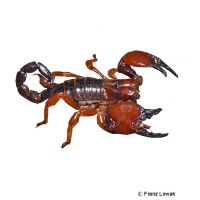Tanzanian Red Clawed Scorpion (Pandinoides cavimanus)
| Tanzanian Red Clawed Scorpion Pandinoides cavimanus | |
|---|---|
| Name | Tanzanian Red Clawed Scorpion |
| Name Lat. | Pandinoides cavimanus |
| Synonym | Pandinus cavimanus |
| Family | Scorpions |
| Family lat. | Scorpionidae |
| Order | Scorpions |
| Order lat. | Scorpiones |
| Origin | Kenya, Tanzania |
| Habitat | Humid savanna |
| Diet | Insects |
| Humidity | 60-70 % |
| Behavior | Nocturnal |
| Keeping | Individual |
| Care Level | Easy |
| Housing | Semi-humid terrarium |
| Breeding | Simple |
| Life Span | 5-10 years |
| Protection | No |
| Metric Units | |
| Size | 9-12 cm |
| Temperature Day | 24-28 °C |
| Temperature Night | 20-22 °C |
| Housing Size | 30 x 30 x 30 cm |
| US Units | |
| Size | 3.5"-4.7" |
| Temperature Day | 75-82 °F |
| Temperature Night | 68-72 °F |
| Housing Size | 10" x 10" x 10" |
Distribution and habitat
The nocturnal red scorpions are widespread in Tanzania and Kenya (East Africa). They live in the wet savannahs and tropical rainforests, where they inhabit self-dug, well-protected burrows.
Maintenance
For 1 animal a terrarium of L 30 x W 30 x H 30 cm can be recommended. For a pair or group keeping the terrarium must be extended accordingly. The terrarium should be placed in a quiet and vibration-free place without sunlight.
The terrarium should be structured with stones, cork tubes, pieces of bark, roots and branches (hiding places). They need a small, shallow drinking bowl and a substrate of sand-loam-peat mixture, at least 10-15 cm deep, suitable for digging. The substrate should always be kept slightly moist. Waterlogging and mold must be avoided at all costs. Artificial or potted plants (e.g. Ficus repens, Scindapsus aureus) can be used for decoration. Once a day, preferably in the evening, the interior of the terrarium should be finely sprayed with water (humidity), but it is better to use a rain or fog system
| Temp. day: 24-28 °C | Temp. night: 20-22 °C | Humidity: 60-70 |
The lighting duration should be 8-12 hrs. depending on the season, but is not absolutely necessary for the nocturnal animals. Attention should be paid to their natural day-night rhythm.
Diet
The diet consists of crickets, cockroaches, house crickets, maggots and grasshoppers as well as other arthropods. Wax moths should only be fed in small quantities to adults, but not to juveniles, because of their large fat content
Using fruit and honey water as food for the foragers can enhance their quality. It is important to add minerals and vitamins regularly (dusting the feed animals). Young animals should be offered food daily, adults 1-2 times a week. Feeding should be done only in the evening. Hungry scorpions keep their pedipalpal claws wide open and actively search for food. Drinking water must always be available. They drink a lot, especially pregnant females, and often remain sitting at the edge of the water bowl.
A varied diet promotes health and prevents deficiency symptoms.
Reproduction and breeding
The sex difference is difficult to see. The sexual opening is heart-shaped in the female, oval in the male. Males appear somewhat more slender.
During the "mating dance", which is similar to a wrestling match, a sperm package (spermatophore) is passed. Females can give birth to offspring several times without further mating (sperm storage). After a gestation period of 14-16 months, sometimes longer, the female gives birth to 15-30 young. The white, barely mobile young find protection from predators on the mother's back for at least 2 weeks, until after the 2nd molt. Only then do they begin to feed on their own. Small crickets and house crickets are suitable as rearing food.
Obligation to report
It is essential to find out about any bans on keeping or permits for keeping dangerous animals in your state or municipality (e.g. public order office). Your pet store will be happy to provide you with further information.
Important
Keeping in pairs or in a harem (one male, several females) is possible.
Care should be taken when handling them in the terrarium. They are hardly aggressive and only weakly poisonous, the poisonous effect is similar to that of a bee sting. However, the sting itself can cause severe pain. For relocation, the animals are gripped with a pair of feeding tweezers about 30 cm long at the rear end and not at the front body (risk of injury)
Good ventilation without drafts is necessary, as well as equipment for measuring temperature and humidity. Lighting should be placed in such a way that the animals cannot injure themselves. The terrarium should be locked in such a way that neither unauthorized persons can open it nor the animals can escape. Special attention should be paid to thorough hygiene and impurities should be removed regularly. Further literature can be found in your pet store.
References
Text: petdata; Image: Franz Lowak
Source: HENKEL & SCHMIDT (2010): Taschenatlas Wirbellose für das Terrarium, Verlag Ulmer; WATZ (2008): Skorpione im Terrarium, Verlag Ulmer; ENGELMANN & LANGE (2011): Zootierhaltung - Tiere in menschlicher Obhut, Wirbellose, Verlag Harri Deutsch
